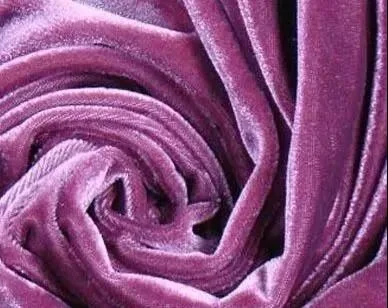What are the differences between the various "velvet" types in fabrics?
- Get link
- X
- Other Apps
What are the differences between the various "velvet" types in fabrics? Which fabric is velvet, flannel...it's unclear. Today we get to know velvet, gold velvet, polar fleece, coral velvet, flannel...
01 Velvet
Raw materials: silk + cotton
Zhangrong is named after its origin in Zhangzhou, Fujian Province, China. It was mass-produced in the Ming Dynasty and is one of China's traditional fabrics. The raw material of velvet is 22-30 cocoon grade A raw silk, silk is also used as the warp, and cotton yarn is the "ground" where the weft is interlaced. Looped with silk or rayon. Both the warp and weft yarns are degummed or semi-degummed, colored, twisted and then woven.
02 golden velvet
Raw materials: silk + viscose fiber (cotton is chemically treated)
Golden velvet is a single-layer raised velvet fabric made of mulberry silk and viscose rayon interlaced. Suede has dense, long and slightly sloping hair, but is not as flat as other types of down. Commonly used for women's work clothes, curtains and decorative items. Gold velvet fabric feels silky and flexible, making clothes really high-end. Although it will shed some hair, it is soft and skin-friendly after washing.
06 Dralon
What is the material of Dralon fabric?
Dralon is a kind of chemical fiber fabric. The fabric composition is relatively complex, but it is generally based on polyacrylonitrile fiber, and will be blended with a certain proportion of spandex and polyester fiber. Of course, some Dralon fabrics will also be blended with chemical fiber fabrics. A certain proportion of viscose fiber gives the fabric a certain moisture permeability!
dralon fabric is a kind of fabric suitable for close-fitting wear. The advantages of dralon fabric are:
1. The textile technology of dralon fabric is very good, and the color of the fabric is delicate!
2. The thermal insulation performance of dralon fabric is very good, because there are very fine fluff on the surface of the fabric, forming an air barrier, making the fabric have very good thermal insulation performance!
3. dralon fabric has particularly good wear resistance.
4. The printing and dyeing is reactive printing and dyeing, and it will not fade after repeated washing.
5. The moisture permeability is very good, and it is not prone to pilling!
What kind of fabric is ferret velvet? What is the difference between mink and mink? Ferret down is the down on ferrets. The ferret is a small and rare animal. In order to resist the cold, it has a layer of very soft fluff on its body. After the guard hairs are removed from the fur, the fluff is left to make fur, so it is called ferret fur. This kind of fabric is usually Will be used to make high-end work clothes.
07 ferret velvet
Since the hair of ferret velvet is relatively short, it is not suitable to be directly used as a textile raw material. The ferret velvet yarn on the market is a mixture of man-made fibers and mink velvet.
Mink velvet is not mink velvet. This material is usually more popular in the wool market. In addition to ferrets, there are also materials such as raccoon fur, rabbit fur and wool, which are then mixed and woven using different types of chemical fiber materials.
What is the difference between mink and mink?
Mink velvet is softer and has an average gloss. Mink hair has a better gloss. Although it feels soft, it is still inferior to mink velvet. Mink velvet material can be worn directly next to the body, and mink material is generally used to make fur.
Mink fur is generally very expensive, and its thermal insulation effect is very good. The price of mink sweaters is more expensive than ordinary sweaters, but because it is made of mixed textile materials, the price is much cheaper than mink.
Mink fur cannot be washed and needs to be stored away from light, but mink velvet clothes can be washed or dry-cleaned. However, when washing, the washing temperature should not exceed 40 degrees to avoid deformation of mink clothes.
To learn more, please follow Stonesportswear
- Get link
- X
- Other Apps








Comments
Post a Comment
Thank you for your feedback